无线充电技术Wireless Charging
qi无线充电协议
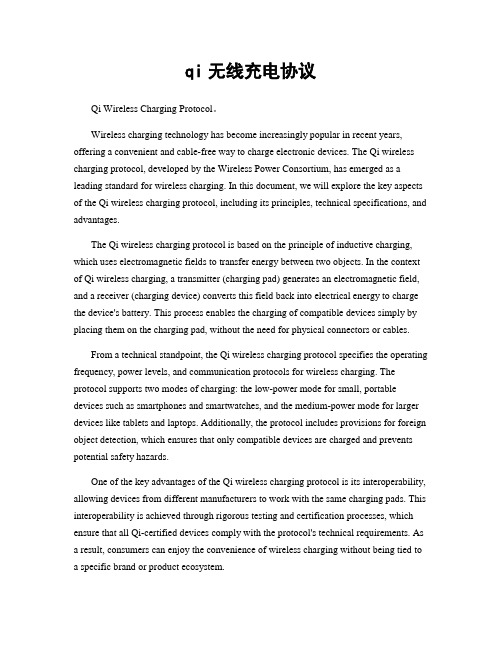
qi无线充电协议Qi Wireless Charging Protocol。
Wireless charging technology has become increasingly popular in recent years, offering a convenient and cable-free way to charge electronic devices. The Qi wireless charging protocol, developed by the Wireless Power Consortium, has emerged as a leading standard for wireless charging. In this document, we will explore the key aspects of the Qi wireless charging protocol, including its principles, technical specifications, and advantages.The Qi wireless charging protocol is based on the principle of inductive charging, which uses electromagnetic fields to transfer energy between two objects. In the context of Qi wireless charging, a transmitter (charging pad) generates an electromagnetic field, and a receiver (charging device) converts this field back into electrical energy to charge the device's battery. This process enables the charging of compatible devices simply by placing them on the charging pad, without the need for physical connectors or cables.From a technical standpoint, the Qi wireless charging protocol specifies the operating frequency, power levels, and communication protocols for wireless charging. The protocol supports two modes of charging: the low-power mode for small, portable devices such as smartphones and smartwatches, and the medium-power mode for larger devices like tablets and laptops. Additionally, the protocol includes provisions for foreign object detection, which ensures that only compatible devices are charged and prevents potential safety hazards.One of the key advantages of the Qi wireless charging protocol is its interoperability, allowing devices from different manufacturers to work with the same charging pads. This interoperability is achieved through rigorous testing and certification processes, which ensure that all Qi-certified devices comply with the protocol's technical requirements. As a result, consumers can enjoy the convenience of wireless charging without being tied to a specific brand or product ecosystem.Furthermore, the Qi wireless charging protocol prioritizes safety and efficiency, incorporating features such as overvoltage protection, overcurrent protection, and temperature control to safeguard both the charging pad and the charging device. These safety measures help prevent damage to the devices and reduce the risk of overheating or electrical accidents during the charging process.In terms of practical applications, the Qi wireless charging protocol has been widely adopted in various settings, including homes, offices, public spaces, and automotive environments. Charging pads based on the Qi standard are integrated into furniture, vehicles, and consumer electronics, providing users with seamless access to wireless charging wherever they go. This widespread adoption has contributed to the growing popularity of wireless charging and has driven the development of innovative products and solutions in the wireless power industry.In conclusion, the Qi wireless charging protocol represents a significant advancement in the field of wireless power transfer, offering a reliable, safe, and interoperable solution for charging electronic devices. As the demand for wireless charging continues to grow, the Qi standard is poised to play a central role in shaping the future of wireless power technology. By adhering to the principles and technical specifications of the Qi wireless charging protocol, manufacturers and consumers can benefit from the convenience and flexibility of wireless charging while ensuring compatibility and safety across a diverse range of devices.。
国家为什么禁止100w无线充电

国家为什么禁止100w无线充电
近年物联网技术发展如日中天,有一种名为“100W无线充电”(Wireless Charging)的充电方式引起了社会的热议,尽管它被认为是当今充电新技术,但由于其可能会影响人体健康,因此许多国家不欢迎用户使用它。
据报道,伦敦市中心最近展示了“100W无线充电”最新技术,现场还有一座11英尺高的充电塔,可以在10米范围内为手机免费充电,而且可以在短短的几秒内完成充电,充分体现了物联网技术的进步。
另外,相比传统的充电,这种无线技术无需线缆连接,用户几乎可以不需要具备技术知识就能充电,十分方便。
目前许多国家已经开始禁止使用这种技术,主要还是因为人们对它的健康安全问题。
据报道,由于这一技术的存在,家里的电磁辐射暴露也超过了正常范围,由此也带来了很多社会健康问题。
此外,由于该技术的存在,人们的睡眠也受到了干扰。
因此,政府发布了一项新规定,明确禁止使用,以保护人们免受这种技术造成的伤害。
另外,政府监管部门也积极了解这一技术带来的风险,加强对研发方面的监管,以防止泛滥使用。
综上所述,尽管“100W无线充电”可以让人们省去用线缆充电的麻烦,极大地提升充电体验,但其存在的健康风险又不可忽视,也决不能妄加使用。
我们都要认真遵守政府的规定,切忌违规使用,以免造成损害大众健康的不愉快后果。
无线充电技术的工作原理
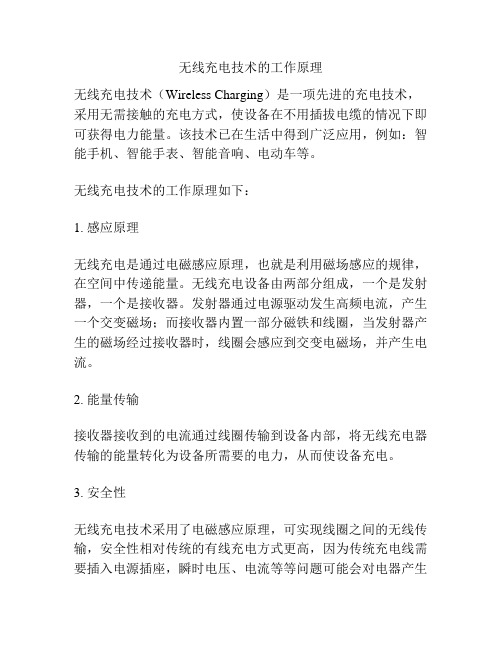
无线充电技术的工作原理无线充电技术(Wireless Charging)是一项先进的充电技术,采用无需接触的充电方式,使设备在不用插拔电缆的情况下即可获得电力能量。
该技术已在生活中得到广泛应用,例如:智能手机、智能手表、智能音响、电动车等。
无线充电技术的工作原理如下:1. 感应原理无线充电是通过电磁感应原理,也就是利用磁场感应的规律,在空间中传递能量。
无线充电设备由两部分组成,一个是发射器,一个是接收器。
发射器通过电源驱动发生高频电流,产生一个交变磁场;而接收器内置一部分磁铁和线圈,当发射器产生的磁场经过接收器时,线圈会感应到交变电磁场,并产生电流。
2. 能量传输接收器接收到的电流通过线圈传输到设备内部,将无线充电器传输的能量转化为设备所需要的电力,从而使设备充电。
3. 安全性无线充电技术采用了电磁感应原理,可实现线圈之间的无线传输,安全性相对传统的有线充电方式更高,因为传统充电线需要插入电源插座,瞬时电压、电流等等问题可能会对电器产生影响或危害。
无线充电技术具有如下优势:1. 节省时间无线充电可以避免插拔充电线的麻烦,加快充电的速度,让用户更加省时省力。
2. 有效降低安全风险免去了插头接线的过程,不仅安全,也可以保持机器外观整洁,将安全隐患降至最低。
3. 方便快捷无线充电技术带给用户便捷、高效的充电方式,让用户在任何时候、任何地点均可方便快捷地充电,满足了人们日常生活的需求。
4. 为移动设备提供便携性无线充电进一步提高了移动设备的便携性,使设备成为更理想的便携工具。
无线充电技术也存在一些问题:1. 成本高无线充电技术适用于广泛的设备范围,但相较于传统有线充电方式,它的成本仍然偏高,无法普及开来。
2. 充电效率较低目前的无线充电技术对充电效率的限制较多,通常需要在电源与设备之间保持一定的距离才能正常充电,因而效率相对较低,充电时间较长。
3. 兼容性问题当前无线充电技术存在部分产品兼容性不足的问题,一些数据表明,针对不同款式设计的无线充电器在充电时会遇到一定的问题。
connectivity汽车英语词汇
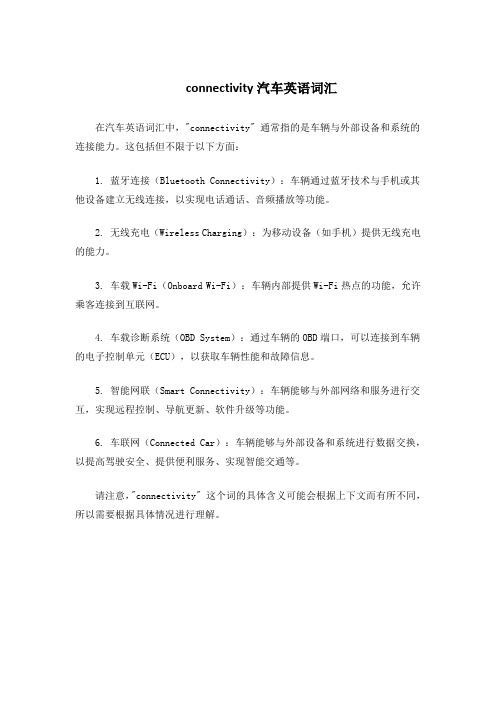
connectivity汽车英语词汇
在汽车英语词汇中,"connectivity" 通常指的是车辆与外部设备和系统的连接能力。
这包括但不限于以下方面:
1. 蓝牙连接(Bluetooth Connectivity):车辆通过蓝牙技术与手机或其他设备建立无线连接,以实现电话通话、音频播放等功能。
2. 无线充电(Wireless Charging):为移动设备(如手机)提供无线充电的能力。
3. 车载Wi-Fi(Onboard Wi-Fi):车辆内部提供Wi-Fi热点的功能,允许乘客连接到互联网。
4. 车载诊断系统(OBD System):通过车辆的OBD端口,可以连接到车辆的电子控制单元(ECU),以获取车辆性能和故障信息。
5. 智能网联(Smart Connectivity):车辆能够与外部网络和服务进行交互,实现远程控制、导航更新、软件升级等功能。
6. 车联网(Connected Car):车辆能够与外部设备和系统进行数据交换,以提高驾驶安全、提供便利服务、实现智能交通等。
请注意,"connectivity" 这个词的具体含义可能会根据上下文而有所不同,所以需要根据具体情况进行理解。
无线充电介绍
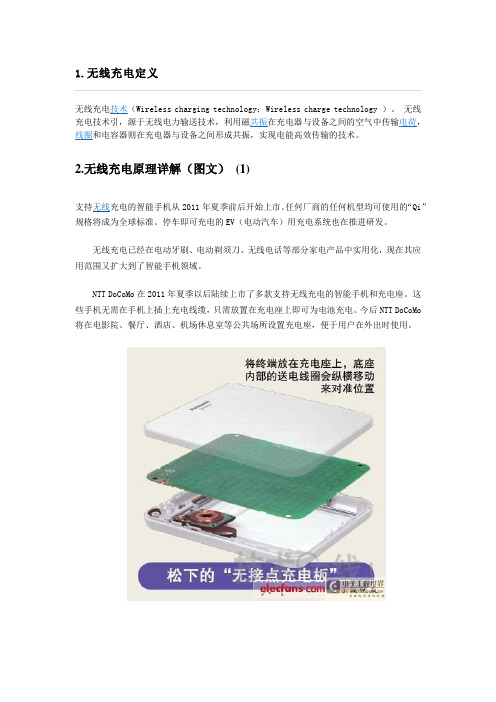
2.无线充电原理详解(图文)(1)支持无线充电的智能手机从2011年夏季前后开始上市。
任何厂商的任何机型均可使用的“Qi”规格将成为全球标准。
停车即可充电的EV(电动汽车)用充电系统也在推进研发。
无线充电已经在电动牙刷、电动剃须刀、无线电话等部分家电产品中实用化,现在其应用范围又扩大到了智能手机领域。
NTT DoCoMo在2011年夏季以后陆续上市了多款支持无线充电的智能手机和充电座。
这些手机无需在手机上插上充电线缆,只需放置在充电座上即可为电池充电。
今后NTT DoCoMo 将在电影院、餐厅、酒店、机场休息室等公共场所设置充电座,便于用户在外出时使用。
软银移动也预定2012年1月上市支持无线充电的智能手机。
KDDI正在开发车载式智能手机的无线充电座。
未来无线充电的应用范围将有望扩大到EV的充电系统。
目前,市场上支持无线充电的智能手机和充电器大部分都符合总部位于美国的业界团体“无线充电联盟(WPC)”所制定的“Qi”规格。
Qi源自汉语“气功”中的“气”,以松下、韩国三星电子、英国索尼爱立信、芬兰诺基亚、电装为首,许多国家的家电厂商和汽车厂商都相继加盟了WPC。
无线充电方式包括“磁共振”及“电波接收”等多种方式,Qi采用的是“电磁感应方式”。
通过实现标准化,只要是带有Qi标志的产品,无论是哪家厂商的哪款机型均可充电。
19世纪发现的物理现象电磁感应方式采用了19世纪上半期发现的物理现象。
众所周知,电流流过线圈时,周围会产生磁场。
1820年,丹麦物理学家汉斯·奥斯特(Hans Oersted)发现了这种电磁效应。
用没有通电的其他线圈接近该磁场,线圈中就会产生电流,由此点亮灯泡。
1831年,英国物理学家迈克尔·法拉第(Michael Faraday)发现了这个可从线圈向线圈供电的物理现象,并称之为电磁感应现象。
无线充电使用的充电座和终端分别内置了线圈,使二者靠近便开始从充电座向终端供电。
无线充qi协议c语言详解无线充电Qi协议正向通信FSK的解调设计
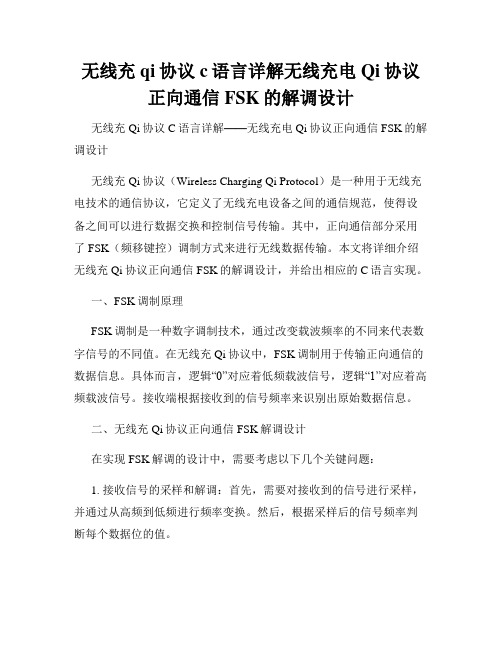
无线充qi协议c语言详解无线充电Qi协议正向通信FSK的解调设计无线充Qi协议C语言详解——无线充电Qi协议正向通信FSK的解调设计无线充Qi协议(Wireless Charging Qi Protocol)是一种用于无线充电技术的通信协议,它定义了无线充电设备之间的通信规范,使得设备之间可以进行数据交换和控制信号传输。
其中,正向通信部分采用了FSK(频移键控)调制方式来进行无线数据传输。
本文将详细介绍无线充Qi协议正向通信FSK的解调设计,并给出相应的C语言实现。
一、FSK调制原理FSK调制是一种数字调制技术,通过改变载波频率的不同来代表数字信号的不同值。
在无线充Qi协议中,FSK调制用于传输正向通信的数据信息。
具体而言,逻辑“0”对应着低频载波信号,逻辑“1”对应着高频载波信号。
接收端根据接收到的信号频率来识别出原始数据信息。
二、无线充Qi协议正向通信FSK解调设计在实现FSK解调的设计中,需要考虑以下几个关键问题:1. 接收信号的采样和解调:首先,需要对接收到的信号进行采样,并通过从高频到低频进行频率变换。
然后,根据采样后的信号频率判断每个数据位的值。
2. 数据帧的同步:在接收端解调之前,需要建立一个同步信号,该信号用于定位数据帧的开始位置。
可以利用数据帧中的特定数据模式进行同步。
3. 误码控制和纠错:接收端需要对接收到的数据进行判断,如果出现误码,则进行纠错操作,保证数据的准确性。
三、C语言实现代码示例下面是一个基于C语言的无线充Qi协议正向通信FSK解调设计的代码示例:```c#include <stdio.h>// 定义采样频率#define SAMPLE_RATE 2000// 定义同步信号模式#define SYNC_PATTERN 0xAAAA// 信号采样函数int sampleSignal(){// TODO:采样信号,返回采样值}// 频率识别函数int recognizeFrequency(){// TODO:识别信号频率,返回对应值}// FSK解调函数void fskDemodulation(){int sampleValue;int frequency;// 同步信号检测while (1){sampleValue = sampleSignal();frequency = recognizeFrequency();if (frequency == SYNC_PATTERN) {// 同步信号检测成功,跳出循环 break;}}// 解调数据位while (1){sampleValue = sampleSignal();frequency = recognizeFrequency();// 根据频率识别判断数据位的值// TODO:进行数据处理和纠错操作 }}int main(){// TODO:初始化硬件和设置参数// 执行FSK解调fskDemodulation();return 0;}```以上示例代码中,根据实际情况,通过在`sampleSignal()`函数中进行信号采样,通过在`recognizeFrequency()`函数中进行频率识别,实现了对无线充Qi协议正向通信FSK信号的解调和处理。
无线充电技术
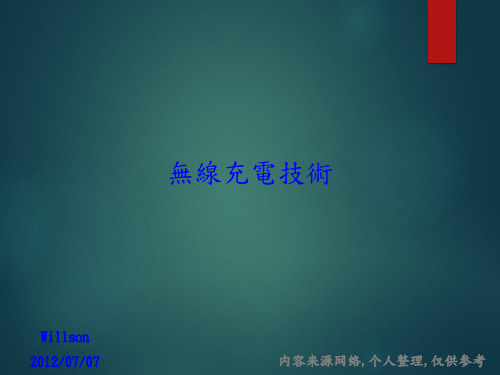
1.利用無線磁電感應充電的設備可做到隱形,設 備磨損率低,應用範圍廣,公共充電區域面積相 對的減小,但減小的占地面積份額不會太大。 2.技術含量高,操作方便,可實施相對來說的遠 距離無線電能的轉換,但大功率無線充電的傳輸 距離只限制在5米以內,不會太遠。 3.操作方便。
1.雖然設備技術含量高,但設備的經濟成本投入較高, 維修費用大。 2.因實現遠距離大功率無線磁電轉換,所以設備的耗能 較高。 3.無線充電設備本身實現的是二次能源轉換,也就是將 網電降壓(或直接)變為直流電後在進行一次較高頻率 的開關控制交流變換輸出。由於大功率的交直交電流轉 換是進行電能的二次性無線傳輸原因,所以電磁的空間 磁損率太大。 4.因為採取無線傳輸,磁能的無用功耗損會隨著設備的 功率增高而上升。 5.無線充電設備的電磁輻射會對生物造成很多不利的因 素。
無線充電的方式:
1.電磁感應式 2.無線電波式 3.磁場共振式 4.其他(微波、超聲波、鐳射,電場耦合)
二、無線充電技術原理
1.電磁感應式
電磁感應——初級線圈通以一定頻率的交流電,通過電磁感應 在次級線圈產生電流,從而將能量從傳輸端轉移到接受端。
二、無線充電技術原理
2.無綫電波式
類似於早期使用的礦石收音機,主要有微波發射裝置和微波接受裝置組 成,接受電路可以捕捉到從牆壁彈回的無線電波能量,在隨負載做出調 整的同時保持穩定的直流電壓。
一、無線充電技術簡介
什麼是無線充電技術?
無線充電技術(Wireless charging technology): 無線充電技術引源於無線電 力輸送技術,利用電磁波感 應原理及相關的交流感應技 術,在發送和接受端用相應 的線圈來發送和接收產生感 應的交流信號來進行充電的 一項技術。
无线充电移动电源

1、概念:无线充电移动电源,英译Wireless charging of mobile power supply。
是指不需要USB线接插,也不用电源线连接插座,即可在户外实现随身无线充电的移动电源。
它和无线充电器有着很大的本质的区别。
无线充电移动电源在2013年上半年来说,在市场上都属于新生事物。
2、原理:无线充电移动电源的原理:在传统移动电源的基础上,增加无线充电功能。
在功能上相当于一款移动电源和一款无线充电器的融合。
因为无线充电需要一个发送端和接收端,因此无线充电移动电源在常规移动电源的基础上安装有发送装置,而充电的手机必须是支持无线充电,具备无线充电的接收线圈。
在发送和接收端各有一个线圈的情况下,发送端线圈连接有线电源产生电磁信号,接收端线圈感应发送端的电磁信号从而产生电流给电池充电。
3、无线充电移动电源和无线充的区别无线充,却是指无线充电器,它本身并不带电源,需要首先连接电源插座,然后才能通过无线方式给手机等设备充电,在实际应用中实用性收到很大限制,概念性比较浓。
无线充电移动电源本身带有电芯,属于电源装置,在不需要外电源的情况下,就可以通过无线的方式给手机等设备充电,是目前真正实用的智能移动电源。
4、主要无线充电移动电源品牌国内移动电源品牌林立,各产品品质也是参差不齐。
移动电源整体来说都缺乏行业标准规范。
很多不法商家都浑水摸鱼。
但是归纳起来,目前为止,国内推出无线充电移动电源产品的品牌并不多,而山寨厂产品虽然也有,但是品质基本难以保障。
行业率先推出无线充电移动电源的品牌主要是超苹数码(Cpadi),其次是美创等激进品牌,传统移动电源厂家如品胜、羽博、飞毛腿等反而落后,目前尚未有相关产品曝光。
5、无线充电移动电源的发展渊源无线充电技术在2007 年获得了20 项专利,多种设备可以使用一台充电基站、手机、随声播放器、电动工具和其他的电源适配器的有线充电情况将不会存在了。
通过使用线圈之间产生的磁场,神奇的传输电能,电感耦合技术将会成为连接充电基站和设备的桥梁。
无线充电
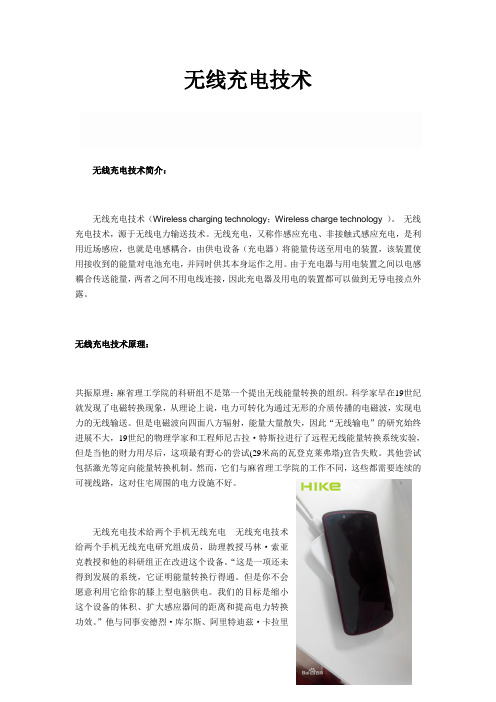
无线充电技术无线充电技术简介:无线充电技术(Wireless charging technology;Wireless charge technology )。
无线充电技术,源于无线电力输送技术。
无线充电,又称作感应充电、非接触式感应充电,是利用近场感应,也就是电感耦合,由供电设备(充电器)将能量传送至用电的装置,该装置使用接收到的能量对电池充电,并同时供其本身运作之用。
由于充电器与用电装置之间以电感耦合传送能量,两者之间不用电线连接,因此充电器及用电的装置都可以做到无导电接点外露。
无线充电技术原理:共振原理:麻省理工学院的科研组不是第一个提出无线能量转换的组织。
科学家早在19世纪就发现了电磁转换现象,从理论上说,电力可转化为通过无形的介质传播的电磁波,实现电力的无线输送。
但是电磁波向四面八方辐射,能量大量散失,因此“无线输电”的研究始终进展不大,19世纪的物理学家和工程师尼古拉·特斯拉进行了远程无线能量转换系统实验,但是当他的财力用尽后,这项最有野心的尝试(29米高的瓦登克莱弗塔)宣告失败。
其他尝试包括激光等定向能量转换机制。
然而,它们与麻省理工学院的工作不同,这些都需要连续的可视线路,这对住宅周围的电力设施不好。
无线充电技术给两个手机无线充电无线充电技术给两个手机无线充电研究组成员,助理教授马林·索亚克教授和他的科研组正在改进这个设备。
“这是一项还未得到发展的系统,它证明能量转换行得通。
但是你不会愿意利用它给你的膝上型电脑供电。
我们的目标是缩小这个设备的体积、扩大感应器间的距离和提高电力转换功效。
”他与同事安德烈·库尔斯、阿里特迪兹·卡拉里斯、罗伯特·莫埃特、约翰·加侬珀洛斯和彼得·索利科合作,进行了这项研究。
项目进展情况:实验成果:走进我们的实验室,研究人员打开了电源,1米外,一个摆放了36个200瓦灯泡的装置没有连接电源线即瞬间被点亮。
没有充电线怎么给手机充电

USB充电器是指用USB接口连接电脑或充电头给电子产品充电的设备。USB充电器主要是将手机连 接到电脑的USB口,由USB口提供电力,创意十足。其充电器结构十分简单,没有大块的变压器, 式样和数据线相同,比原配的充电器要轻便很多,绝对适合居家旅行,充电必备,原来的可以扔 掉了。
没有充电线怎么给手机充电
iPhone 4移动电源是一款聚合物锂电池,电池容量为3700mAh。
没有充电线怎么给手机充电,本篇为大家带来解决办法,感兴趣的小伙伴们一起来看看吧!
第一步,将无线充电器的插头插在插 座上。
第二步,将无线充电器放在平整的桌 子上。
第三步,将手机无线充电接收器部位 放到无线充电器上,即可实现不需要 适配的充电线对手机进行充电。
万能充电器能给多种类型的可充电电池充电,以手机电池为主,几乎能给所有的手机电池充电, 所以称万能充电器。
感应充电是非接触式充电,接插件内部设有一降压整流电路、一电磁波发射电路,其中市电与降 压整流电路的两输入端相连,降压整流电路的两输出端与电磁波发射电路的两输入端相连,电磁 波发射电路的输出端连接有一发射线圈,该发射线圈设置在所述充电插头内,而发射线圈的外部 包裹有一橡塑绝缘层。
欢迎评论区交流攻略!感谢的charging technology;Wireless charge technology ),源于无 线电能传输技术,可分为小功率无线充电和大功率无线充电两种方式。
小功率无线充电常采用电磁感应式,如对手机充电的Qi方式,但中兴的电动汽车无线充电方式采 用感应式 。大功率无线充电常采用谐振式(大部分电动汽车充电采用此方式)由供电设备(充 电器)将能量传送至用电的装置,该装置使用接收到的能量对电池充电,并同时供其本身运作之 用。
无线充电技术

无线充电技术,即Wireless charging technology,是指具有电池的装置不需要借助于电导线,利用电磁波感应原理或者其他相关的交流感应技术,在发送端和接收端用相应的设备来发送和接收产生感应的交流信号来进行充电的一项技术,源于无线电力输送技术。
无线充电技术的研究,源于19世纪30年代,迈克尔-法拉第发现电磁感应现象,即磁通量变化产生感应电动势,从而在电线中产生电流。
但最早的无线电力传输思想是尼古拉-特斯拉(Nikola Tesla)在19世纪90年代提出的无线电力传输构想和无线输电试验,因而有人称之为无线电能传输之父。
技术原理从具体的技术原理及解决方案来说,目前无线充电技术主要有电磁感应式、磁共振式、无线电波式、电场耦合式四种基本方式。
这几种技术分别适用于近程、中短程与远程电力传送。
各种无线充电方式都有各自的特点,具体比较如表1所示。
表1 无线充电各种原理方案的比较当前最成熟、最普遍的是电磁感应式。
其根本原理是利用电磁感应原理,类似于变压器,在发送端和接收端各有一个线圈,初级线圈上通一定频率的交流电,由于电磁感应在次级线圈中产生一定的电流,从而将能量从传输端转移到接收端,如图1所示。
PWC联盟发起者Powermat公司用电磁感应式推出过一款WiCC充电卡,与SD卡差不多大,内部嵌有线圈和电极等组件,插入现有智能手机电池旁边即可使用。
图1 电磁感应式无线充电原理磁共振式无线充电#e#磁共振式也称为近场谐振式,由能量发送装置,和能量接收装置组成,当两个装置调整到相同频率,或者说在一个特定的频率上共振,它们就可以交换彼此的能量,其原理与声音的共振原理相同,排列在磁场中的相同振动频率的线圈,可从一个向另一个供电,如图2。
技术难点是小型化和高效率化,被认为是将来最有希望广泛应用于电动汽车无线充电的一种方式。
图2 磁共振式无线充电示意图无线电波式,基本原理类似于早期使用的矿石收音机,主要有微波发射装置和微波接收装置组成。
无线充电技术
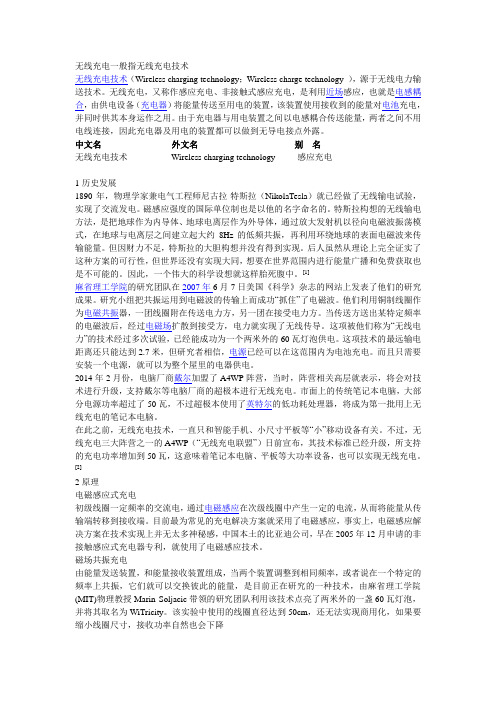
无线充电一般指无线充电技术无线充电技术(Wireless charging technology;Wireless charge technology ),源于无线电力输送技术。
无线充电,又称作感应充电、非接触式感应充电,是利用近场感应,也就是电感耦合,由供电设备(充电器)将能量传送至用电的装置,该装置使用接收到的能量对电池充电,并同时供其本身运作之用。
由于充电器与用电装置之间以电感耦合传送能量,两者之间不用电线连接,因此充电器及用电的装置都可以做到无导电接点外露。
中文名外文名别名无线充电技术Wireless charging technology 感应充电1历史发展1890年,物理学家兼电气工程师尼古拉·特斯拉(NikolaTesla)就已经做了无线输电试验,实现了交流发电。
磁感应强度的国际单位制也是以他的名字命名的。
特斯拉构想的无线输电方法,是把地球作为内导体、地球电离层作为外导体,通过放大发射机以径向电磁波振荡模式,在地球与电离层之间建立起大约8Hz的低频共振,再利用环绕地球的表面电磁波来传输能量。
但因财力不足,特斯拉的大胆构想并没有得到实现。
后人虽然从理论上完全证实了这种方案的可行性,但世界还没有实现大同,想要在世界范围内进行能量广播和免费获取也是不可能的。
因此,一个伟大的科学设想就这样胎死腹中。
[1]麻省理工学院的研究团队在2007年6月7日美国《科学》杂志的网站上发表了他们的研究成果。
研究小组把共振运用到电磁波的传输上而成功“抓住”了电磁波。
他们利用铜制线圈作为电磁共振器,一团线圈附在传送电力方,另一团在接受电力方。
当传送方送出某特定频率的电磁波后,经过电磁场扩散到接受方,电力就实现了无线传导。
这项被他们称为“无线电力”的技术经过多次试验,已经能成功为一个两米外的60瓦灯泡供电。
这项技术的最远输电距离还只能达到2.7米,但研究者相信,电源已经可以在这范围内为电池充电。
而且只需要安装一个电源,就可以为整个屋里的电器供电。
无线充电技术英语

5
Prospection 发展前景
Classification
1.Traditional Rechargeable battery
Wirecharging, convert the alternating current to low v oltage direct current.
2.The trend of the future charging
Wireless charging technology 无线充电技术
1
The classification of charging 充电分类
2
Working Principle 工作原理
3 Background and present situation 背景与现状
4
Application 应用
D: 1.Higher equipment investment, maintenance costs. 2.Higher energy consumption. 3.Big electromagnetic space loss rate.
Prospection
Now, the wireless charging technology in the small power within the scope of the can still shows its superiority.But implementation of high power wireless transmission, it was more difficult.Although now wireless charging whether in the theory and technology in there are many problems, but the progress of science and technology will eventually solve them, global wireless charging is not a distant dream, ultimately, in the near future can be realized.
无线充电技术详解
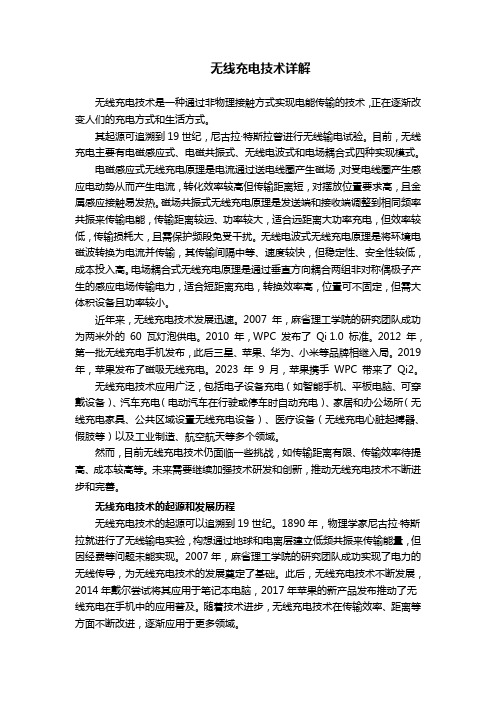
无线充电技术详解无线充电技术是一种通过非物理接触方式实现电能传输的技术,正在逐渐改变人们的充电方式和生活方式。
其起源可追溯到19世纪,尼古拉·特斯拉曾进行无线输电试验。
目前,无线充电主要有电磁感应式、电磁共振式、无线电波式和电场耦合式四种实现模式。
电磁感应式无线充电原理是电流通过送电线圈产生磁场,对受电线圈产生感应电动势从而产生电流,转化效率较高但传输距离短,对摆放位置要求高,且金属感应接触易发热。
磁场共振式无线充电原理是发送端和接收端调整到相同频率共振来传输电能,传输距离较远、功率较大,适合远距离大功率充电,但效率较低,传输损耗大,且需保护频段免受干扰。
无线电波式无线充电原理是将环境电磁波转换为电流并传输,其传输间隔中等、速度较快,但稳定性、安全性较低,成本投入高。
电场耦合式无线充电原理是通过垂直方向耦合两组非对称偶极子产生的感应电场传输电力,适合短距离充电,转换效率高,位置可不固定,但需大体积设备且功率较小。
近年来,无线充电技术发展迅速。
2007 年,麻省理工学院的研究团队成功为两米外的60 瓦灯泡供电。
2010 年,WPC 发布了Qi 1.0 标准。
2012 年,第一批无线充电手机发布,此后三星、苹果、华为、小米等品牌相继入局。
2019 年,苹果发布了磁吸无线充电。
2023 年9 月,苹果携手WPC 带来了Qi2。
无线充电技术应用广泛,包括电子设备充电(如智能手机、平板电脑、可穿戴设备)、汽车充电(电动汽车在行驶或停车时自动充电)、家居和办公场所(无线充电家具、公共区域设置无线充电设备)、医疗设备(无线充电心脏起搏器、假肢等)以及工业制造、航空航天等多个领域。
然而,目前无线充电技术仍面临一些挑战,如传输距离有限、传输效率待提高、成本较高等。
未来需要继续加强技术研发和创新,推动无线充电技术不断进步和完善。
无线充电技术的起源和发展历程无线充电技术的起源可以追溯到19世纪。
1890年,物理学家尼古拉·特斯拉就进行了无线输电实验,构想通过地球和电离层建立低频共振来传输能量,但因经费等问题未能实现。
电动汽车的充电时间比较

电动汽车的充电时间比较随着环境保护意识的增强以及对节能减排的要求不断提高,电动汽车作为一种清洁、高效的交通工具正日益受到人们的关注和青睐。
然而,与传统燃油汽车相比,电动汽车在充电时间方面存在一定的挑战。
本文将从不同类型的电动汽车和充电技术两个方面来比较电动汽车的充电时间。
一、不同类型的1. 纯电动汽车(BEV)纯电动汽车是指完全依靠电池储能的汽车,其充电时间主要取决于电池的容量和充电桩的功率。
目前市面上的纯电动汽车大多采用锂离子电池,充电时间一般在6-8小时左右。
当然,充电时间也会受到充电桩功率的影响,充电桩功率越高,充电时间越短。
一些快充站甚至可以在30分钟内将电池充至80%左右。
2. 插电式混合动力汽车(PHEV)插电式混合动力汽车是指既可以使用电池进行纯电动驱动,也可以使用发动机进行燃油驱动的汽车。
相比于纯电动汽车,插电式混合动力汽车充电时间一般更快,因为其电池容量较小。
一般情况下,插电式混合动力汽车的充电时间在2-4小时之间。
3. 燃料电池汽车(FCEV)燃料电池汽车是将氢气与氧气反应产生电能驱动汽车的一种新型动力技术。
燃料电池汽车的充电时间主要取决于氢气加注的速度,一般情况下,充满一次氢气需要3-5分钟左右。
二、充电技术的进展对充电时间的影响随着科技的进步,充电技术也在不断发展和改进,努力解决电动汽车充电时间长的问题。
以下是目前主要的充电技术及其对充电时间的影响:1. 直流快速充电技术(DC Fast Charging)直流快速充电技术可以大幅缩短电动汽车的充电时间。
通过使用高功率的充电桩,直流快速充电技术可以将电动汽车的电池充至80%左右只需30分钟左右的时间。
这一技术的发展为电动汽车出行提供了更高效、更便捷的充电体验。
2. 无线充电技术(Wireless Charging)无线充电技术是近年来逐渐兴起的一种充电方式。
利用电磁场将电能从充电器传输到电动汽车的电池中,无需插拔充电线,方便快捷。
手机无线充电技术解析

手机无线充电技术解析随着科技的不断进步,手机已经成为我们生活中不可或缺的一部分。
然而,随之而来的问题就是手机电池的续航时间。
为了解决这一问题,无线充电技术应运而生。
本文将对手机无线充电技术进行解析,探讨其原理、优势和未来发展趋势。
一、无线充电技术的原理无线充电技术的原理是通过电磁感应或者电磁辐射将电能传输到手机电池中,从而实现充电的功能。
其中,电磁感应是最常见的一种方式。
它通过在手机和充电设备之间建立一个电磁场来传输能量。
当手机处于充电设备的电磁场范围内时,电磁感应会产生电流,从而将能量传输到手机电池中。
二、无线充电技术的优势与传统有线充电方式相比,无线充电技术具有以下几个优势。
首先,无线充电技术摆脱了传统充电线的束缚,使得手机在充电时更加自由。
无需插拔充电线,只需将手机放在充电设备上即可开始充电,极大地方便了用户的使用。
其次,无线充电技术可以减少电池充电口的磨损。
传统的有线充电方式需要频繁地插拔充电线,长期使用容易导致充电口松动或者损坏。
而无线充电技术可以避免这一问题,有效延长了手机的使用寿命。
此外,无线充电技术还可以减少电线的使用量,降低了对环境的影响。
传统充电线的生产和处理过程都会产生大量的废弃物,而无线充电技术可以减少这一环境负担,符合可持续发展的理念。
三、无线充电技术的发展趋势目前,无线充电技术已经在一些手机和充电设备上得到了应用,但仍然存在一些限制和挑战。
未来,随着技术的不断进步,无线充电技术有望实现更大的突破。
首先,无线充电技术的传输距离有望进一步增加。
目前,大多数无线充电设备的传输距离较短,需要将手机放置在充电设备上才能进行充电。
未来,随着技术的发展,传输距离有望扩大,用户可以在更远的距离范围内进行充电。
其次,无线充电技术的充电效率有望提高。
目前,无线充电技术的充电效率相对较低,能量传输过程中会损耗一部分能量。
未来,科研人员可以通过改进传输方式和材料,提高充电效率,减少能量损耗。
- 1、下载文档前请自行甄别文档内容的完整性,平台不提供额外的编辑、内容补充、找答案等附加服务。
- 2、"仅部分预览"的文档,不可在线预览部分如存在完整性等问题,可反馈申请退款(可完整预览的文档不适用该条件!)。
- 3、如文档侵犯您的权益,请联系客服反馈,我们会尽快为您处理(人工客服工作时间:9:00-18:30)。
With
PROSPECT: QUITE BRIGHT
WHAT WE ARE DOING
A PROMISING IDEA
Wi-Fi
signals are almost everywhere now, a lot of energy is wasted. We need to implement green communication and reduce electromagnetic pollution.
PRESENTATION THEME: WIRELESS CHARGING
AND ENERGY HARVESTING
Speaker: Wang Biao Student ID: 1130349094
APPLICATIONS OF WIRELESS CHARGING
Samsung: Charging Pad Nokia: Charging Shell
Design
THANK YOU!
Google Nexus: Charging Orb
FURTHER APPLICATIONS IN DAILY LIFE
THE PRINCIPLE OF WIRELESS CHARGING
Inductive charging (also known as "wireless charging") uses an electromagnetic field to transfer energy between two objects. This is usually done with a charging station. Energy is sent through an inductive coupling to an electrical device, which can then use that energy to charge batteries or run the device.
DISADVANTAGES
Lower efficiency, waste heat More costly--- 40/50$ vs. 40RMB Inconvenience--- can’t move it too far Incompatibility---Qi has become a standard adopted by many companies such as Google and Nokia.
a block that could constantly check and scavenge the energy from surrounding RF signals, of course, without interfering with normal information transfer. Quick Scan Over Wireless Charging
ADVANTAGES
Convenience - rather than having to connect a power cable, the device can be placed on or close to a charge plate or stand. Durability - Without the need to constantly plug and unplug the device, there is significantly less wear and tear on the socket of the device and the attaching cable .
ABOUT CHARGING TIME
Samsung Pad: 3.922h
Charge Over USB
WIRELESห้องสมุดไป่ตู้ CHARGING SPECIFICATIONS
Currently
the Qi adopts 0-5W low-power specification, but the new medium-power specification of about 12-15W will come up soon in late 2013 by the WPC(Wireless Power Consortium) . the new specification coming out, the charging time would be greatly decreased by roughly 3 times. That would give us more convenience and mobility.
